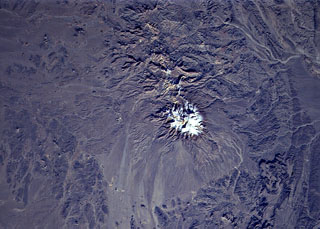Report on Taftan (Iran) — April 1993
Bulletin of the Global Volcanism Network, vol. 18, no. 4 (April 1993)
Managing Editor: Edward Venzke.
Taftan (Iran) Lava flow reported; no previous historical eruptions known
Please cite this report as:
Global Volcanism Program, 1993. Report on Taftan (Iran) (Venzke, E., ed.). Bulletin of the Global Volcanism Network, 18:4. Smithsonian Institution. https://doi.org/10.5479/si.GVP.BGVN199304-232050
Taftan
Iran
28.6°N, 61.13°E; summit elev. 3940 m
All times are local (unless otherwise noted)
An eruption that sent a lava flow ~60 m downslope was reported on 25 April by the Islamic Republic News Agency. No additional information about the timing or location of the activity was available. There was apparently no immediate danger to the local population.
Geological Summary. Taftan is a strongly eroded andesitic stratovolcano with two prominent summits. The volcano was constructed along the Makran-Chagai Arc in SE Iran. The higher SE summit cone has been the source of lava flows, as well as of highly active, sulfur-encrusted fumaroles. In January 1902 the volcano was reported to be smoking heavily for several days, with occasional strong night-time glow. A lava flow was reported in 1993, but may have been a mistaken observation of a molten sulfur flow. Despite these reports there is no clear evidence for Holocene activity. The youngest date obtained by Pang et al. (2014), using U-Pb on a zircon, was about 800 ka. Biabangard and Moradian (2008) obtained K-Ar dates around 700 ka.
Information Contacts: AP; Reuters.

